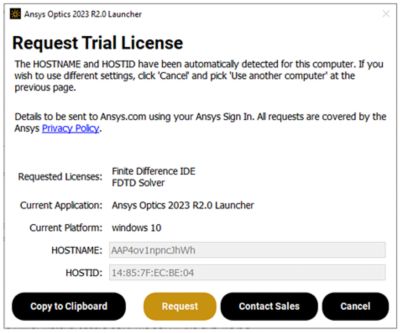-
United States -
United Kingdom -
India -
France -
Deutschland -
Italia -
日本 -
대한민국 -
中国 -
台灣
-
Ansys s'engage à préparer les étudiants d'aujourd'hui à la réussite, en leur fournissant gratuitement un logiciel de simulation.
-
Ansys s'engage à préparer les étudiants d'aujourd'hui à la réussite, en leur fournissant gratuitement un logiciel de simulation.
-
Ansys s'engage à préparer les étudiants d'aujourd'hui à la réussite, en leur fournissant gratuitement un logiciel de simulation.
-
Contactez-nous -
Carrières -
Étudiants et universitaires -
-
S'inscrire -
Déconnexion -
Espace client -
Support -
Communautés partenaires -
Contacter le service commercial
Pour les États-Unis et le Canada
+1 844.462.6797
-
ANSYS BLOG
August 1, 2023
Ansys Optics Launcher Boosts Customer Experience
Most optical engineers and designers use more than one tool while developing a product or device. As many can attest, shifting between tool sets while keeping a project on track can be overwhelming. Adding to this challenge is the need to access files across different programs, which slows down and interrupts the creative process, ultimately affecting design and product timelines.
To improve user experience, the Ansys Optics team has developed a new one-stop launcher application that streamlines workflows and boosts productivity. Available with the latest updates from Ansys 2023 R2, the Ansys Optics Launcher is now installed in Ansys Speos, Ansys Lumerical, and Ansys Zemax OpticStudio. Serving as a launchpad for all your Ansys optics licenses and projects, the application provides access to simulation project files, free trials, license setup, product descriptions, and links to the Ansys website for learning and support.
A Launchpad for Your Ansys Optical Tools
Ansys optics users can easily access the launcher, which is a standalone application available through the start menu on Windows. You will need an Ansys account and the Ansys license manager to get started. To access or register for an Ansys account, visit the Ansys Customer Center.

The Ansys Optics Launcher provides direct access to the Ansys Optics Application Gallery, which includes nearly 100 simulation project files to assist designers and engineers.
The Ansys Optics Launcher was designed to be an intuitive application with an interactive interface. This means that the application includes information about the licenses and software installed on your computer and gives you the option to start a new project using any of your favorite optics and photonics simulation tools. By clicking the solver tab, you can launch any installed applications on your computer. With all your optical simulation tools in one place, you can spend more time on design and less time searching for tools or files.
Similarly, the recent project tab is a significant time saver. This tab gives you access to your previous work in seconds, which is particularly handy when your designs involve complex multiphysics workflows that require multiple programs.
One of the most beneficial features of the launcher is its direct access to the Ansys Optics Application Gallery, which contains nearly 100 simulation project files that can help you get started right away. From photonic integrated circuits to stray light analysis, examples can be searched by keyword, application, or industry. You can easily click to read more about a particular project and discover the tools required to run the simulation.

You can request a free trial of the Ansys Optics Launcher from within Ansys Speos, Ansys Lumerical, and Ansys Zemax OpticStudio.
Explore More of Ansys Optics
If you are a regular user of one Ansys optical product but unfamiliar with another, you are in the right place. You can read software descriptions or request a 30-day trial license to evaluate Speos, Lumerical, or OpticStudio.
Speos accurately predicts the illumination and performance of optical systems with an intuitive and comprehensive user interface. In addition, when powered by graphics processing unit (GPU) computation, Speos delivers significant improvements to simulation performance, 140-260 times faster than CPU computation on average for standard simulation benchmarks. One of the most valuable features in Speos is its human vision component. With this capability, designers can determine perception aspects such as visibility, legibility, and reflection according to the individual human observer.
Leveraging robust algorithms for solving complex electromagnetic problems at the wavelength scale, Lumerical is a popular choice for modeling nanophotonic devices, processes, and materials. The software offers an integrated design environment that features scripting capabilities, advanced post-processing, and optimization routines. Additionally, through streamlined data exchange interfaces with Speos and OpticStudio, Lumerical enables a full, integrated optical solution from the subwavelength to the macroscale.

Ansys Zemax OpticStudio and Ansys Speos are used in tandem to optimize head-up display (HUD) designs in the automotive industry.
For the design of robust, high-precision optical components and subassemblies, optical engineers and designers turn to OpticStudio, which provides everything needed to simulate, optimize, and tolerance these components. With OpticStudio, engineers can accurately design optical components for a variety of applications, from cell phone cameras to laser beam expanders, optical interconnects to head-up displays, and much more. To further streamline your complex design workflows, you can dynamically link OpticStudio to the Lumerical rigorous coupled-wave analysis (RCWA) solver for calculating the diffraction efficiency of complex 2D gratings designed with Lumerical (when Lumerical FDTD is installed on the same PC). With this capability, you can use co-simulation to optimize the grating design to achieve optimal performance for use in advanced augmented reality (AR) and head-up display (HUD) systems.
Discover the Sights for Yourself
To learn more about the Ansys Optics Launcher, visit Ansys Optics or register for one of the following webinars:










